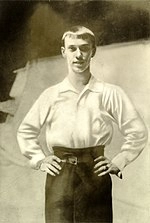How to Pronounce Vaslav Nijinsky
#50
Most Popular
Boost
Mar 12, 1889 Kiev, Ukraine Died on 08 Apr 1950 (aged 61)
Russian ballet dancer and choreographer
PiscesVaslav Nijinsky, Date of Birth, Place of Birth, Family, Facts, Age, Net Worth, Biography and More in FamedBorn.com

Russian ballet dancer and choreographer
Pisces